Menus
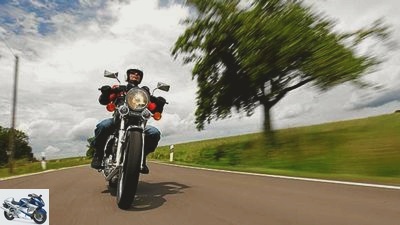


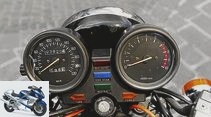
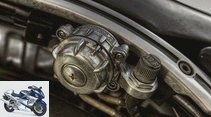
10 photos

Jorg Kunstle
1/10
Cult again today: the small, lockable utensil box at the rear under the delicate one "Luggage rack" only had the original TR1 from 1981. 1982 came a rump.
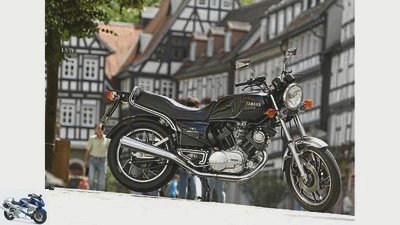
Jorg Kunstle
2/10
Slim stature, long wheelbase, comfortable bench, 1000 V2. Ideal for the really big tour.
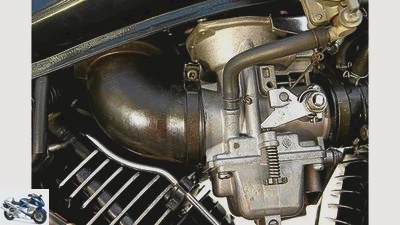
Jorg Kunstle
3/10
Good for surprises: the intake ports of the two Hitachi constant pressure carburettors sometimes jumped off due to misfires when starting the car.
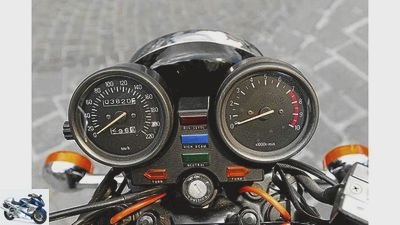
Jorg Kunstle
4/10
Simply beautiful: classic, clearly drawn, easily readable watches. Note the virgin mileage of our anniversary copy.
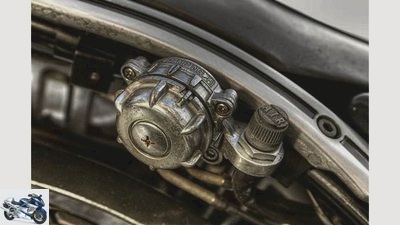
Jorg Kunstle
5/10
Sixfold adjustment of the rear wheel damping including air support.
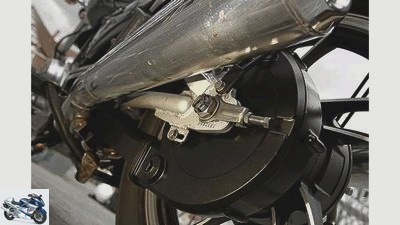
Jorg Kunstle
6/10
Good for 50,000 kilometers: In the closed box, a generously dimensioned chain runs in a lithium grease bath. Small leaks were the rule.

Jorg Kunstle
7/10
Work of art: The starter celebrated the start of the short-stroke V2 engine with acoustics worth hearing, but was not spared from defects.
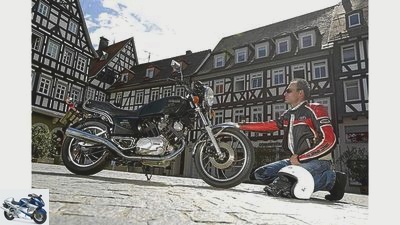
Jorg Kunstle
8/10
The TR1 has never kept the Yamaha promise. For this she has crept into the hearts of her owners forever with running culture, reliability and small quirks.
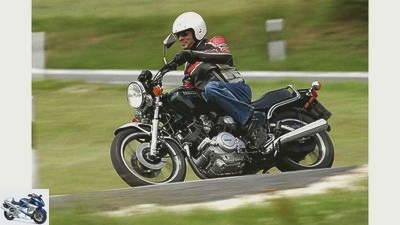
Jorg Kunstle
9/10
Character and smooth running even without balancer shafts.
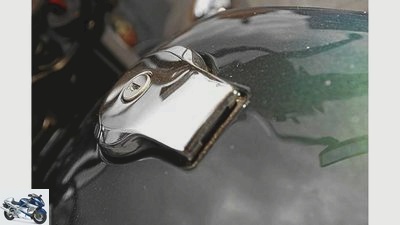
Jorg Kunstle
10/10
Work of art in chrome: solid fuel filler cap that dominates the 19 liter steel tank.
On the move with the Yamaha TR 1
30 years of the Yamaha TR 1
Content of
The TR1 has never kept the Yamaha promise. In return, it has crept into the hearts of its owners forever with its smooth running, reliability and little quirks
A dry blow, tooth flanks clap each other, an electric motor whines, then the V2 ignites and throws softly to itself. Starting the Yamaha TR1 is a kind of initiation experience that brings the fans upright neck hair and happiness hormones every time.
W.As the starter has to strain itself acoustically, one always fears that it won’t be able to do it in time. But most of the time he manages. Then when the 1000er starts work and lapses into its solid resting pulse, the world shines in new splendor. This rich, bassy grinding, with which the thick 500 pistons cover their short distances, made us addicted.
From then on we read everything we could find about this charismatic motorcycle, which was full of unusual technical solutions. Vertically divided press plate frame, load-bearing motor, cantilever rocker, grease chain box and, above all, power from the lowest speeds. Finally stop organizing to zoom in on the horizon, a cautious twitch of the right wrist and our dreams would come true. The enormous torque could break out the rear end of the curve, wrote a tester for the magazine "hobby".
My friend Paul was the first to buy this fabled Yamaha. When he left her for a quick spin, I knew what I wanted to work for. The motorcycle was sensual, it exerted a casual eroticism on its disciples, but to the chagrin of Yamaha it was not mass-compatible. We delighted ourselves in the acoustics of the V2 and even went so far as to listen to the constructive efforts to reduce mechanical noise.
Admired Yamaha’s engine developers Kunihiko Morinaga and Hajime Ueno for their tricks: camshaft control via straight-toothed intermediate gears with torsional dampers and quietly running toothed chains, intake air that whispered through the frame, no Nikasil coating of the cylinder bores, instead centrifugal cast sleeves, the piston noises were better attenuated.
Yamaha doesn’t make musical instruments for nothing, and the TR1 was proof that a combustion engine didn’t have to be loud to compose a sound that had what it takes to intoxicate the driver. When I was finally able to talk about his 81 TR1 in dark green to a suffering owner, a new era began in my motorcycle career. The relationship lasted six years, then it came to a violent end.
Jorg Kunstle
TR1: one that creates order on the country road.
Both the driver and the machine were outwardly calm, but beneath the surface it was seething. Broken shift shaft, worn starter freewheel, leaky chain case, chipped carburetors and various little things (the head gasket was already made by the previous owner) spiced up the time as well as contemplative, low-speed tours with Paul and his meanwhile "Lola" baptized TR1.
For me, the trips with Paul were the ones that best lived up to the essence of TR1. Enjoyable gliding on the torque shaft with 2800 tours and 80 things on narrow French country roads, inhale scents and enjoy the lush roadholding. Not the acceleration duels and private races against the planes of my Ruhr area friends. That was way below TR’s dignity, but she still had to go through it.
Main opponents were Yamaha’s smaller XJ models like a 550. My opponents always teased me that I would be them on the highway "with 1000 cubic" could not drive away and that my machine the same narrow "Peeling" carried on the rims like their middle class files. The TR1 turned willingly, cultivated and without complaint even over 7000 / min, never lost its composure, except when it belched a misfire while starting and blew off one of its carburettors.
A bad habit that I gave her away shortly before her death with the sheet metal flanges from the XV Chopper models. 20 years later, the wounds have still not healed, Paul’s Lola is still in his garage, waiting for her faithful prince to kiss her again this year. It’s summer now, I’m standing in the parking lot at Motorcorner, Goppingen and can’t believe my eyes. For the 30th birthday of the model Yamaha TR1 stands "my" Motorcycle in front of me again.
3700 kilometers on the speedometer, paintwork and chrome almost like from a store, dark green and just beautiful. From the pool of Motorcorner veteran Manuel Wahl. My heart beats as loud as the starter. The procedure is exactly like it was back then, a motorcycle that has fallen out of time and now invites me to spend a day with it. My God, how deep and far back you sit. The young-at-heart green gently pushes off the clutch, the second gear needs a little pressure.
Switch through smoothly and quickly up to the fifth, which can then also remain in it when driving through town. Despite the ultra-short-stroke design, the low-vibration V2 cautiously picks up the gas below 2000 rpm, emphatically pushing the 248 kilogram machine forward with a full tank. I still delight in the sound that escapes from the two chrome-plated megaphone bags, so full, creamy and full of well-oiled metallic precision.
A divine V2, but modest and shy compared to his grandson from the current Yamaha MT-01. At the beginning of the eighties, the TR1 was a steam hammer, much more than just two XT 500 cylinders coupled together, today it is a commitment to understatement for quiet connoisseurs. And for me one of the most characterful Japanese two-cylinder motorcycles ever built. We glide through the landscape, fall easily in curves, not too brisk, the tires are old, the motorcycle wants to live. But I still feel the torsional stiffness of the frame-motor concept, the willingness to work of the De Carbon damper, the characteristics of which can be adjusted by a handwheel, while the spring characteristic is variable with air assistance.
In the past, this did not prevent the occasional breakthrough when the load was fully loaded, but today we are celebrating reunion and not thrashing the lady through potholes. The fork is also air-assisted and can be tuned by changing the pressure. As I ponder, suddenly a twitch in the propulsion.
I have to switch to reserve, remember the two petrol taps, one on each tank bottom. Then everything is good, the drive chain plows through its lithium bed with a chuckle, the TR1 lies full on the road, willingly and with a handy touch it follows the commands. Was the handlebar really that narrow? Has the double disc brake at the front always had so little ambition? Manuel doesn’t want to sell his treasure under any circumstances. Oh, if I still had my old green one. It was also cared for, smelled just like his, which sweetened my day today, always a little like gasoline, rubber and heated chrome polish. Even had the same aroma in the exhaust gas, I cannot control myself sniffing it out in an unobserved moment. Why did she find this unworthy ending??
It was in a parking lot in Switzerland because somehow my fate seems to be linked to Switzerland. Not only are Paul and his Lola real Swiss, no, I always worked there during the semester break to afford my studies and TR1. But some Swiss just don’t like German license plates. One evening a farmer was driving through the town with his exaggeratedly huge four-wheel drive tractor, when the cake tray at the rear of a slim, dark green motorcycle appeared in his cloudy look.
He headed for the parking lot of the inn and simply drove over it. An ugly crunching and breaking of the tin spine, the snorting of the fat diesel and then only the tinkling of the cowbell. What remained was a metal sculpture, the mechanical soul of which found its way into my interior. The cheeky guy was caught, but said he just didn’t like Germans and would not be harmed because his father was close friends with the canton’s police chief.
I fought until I got 5000 francs from his insurance, but that was no replacement and there was no such TR1 again. Manuel, you just have to sell, I’ll get you "Leila" and then it goes together with Paul and Lola far away from performance mania and pressure to accelerate on small French country roads.
archive
Modern technology 1981: ohc heads, load-bearing V2, pressed sheet metal monocoque, cantilever rocker, grease chain box.
In the late 1970s, the cost of fuel, steel, and plastic rose. After a decade of euphoria, customers took a more critical look at the four-cylinder, and began a faint longing for the robust originals from Harley and Vincent with V2 and a lively pulse. This scenario accompanied the development of the Yamaha TR1.
The idea of entering road racing with the large-volume V2 fueled the project. The two-cylinder promised low development costs, higher torque at lower speeds, less friction and less overall width than a four-cylinder.
Yamaha constructed a short-stroke engine with a vertically split crankcase on which identical light-alloy cylinders, rotated by 180 degrees, stand one behind the other at an angle of 75 degrees. This minimized the width and length of the engine and with the "Common parts strategy" the subsequent supply of spare parts is simplified. Despite all design efforts to efficiently cool the rear cylinder, it suffered from thermal problems after its market launch.
Jorg Kunstle
Changes in 1982: brakes, head gasket, seat, rear and maintenance instructions. The V2 ultimately survived in Virago and Bulldog until 2007.
Only the second series from 1982 was able to remedy this with modified seals. The main problem with the TR1, however, was that Yamaha gave up its racing project and quickly positioned the new series 1000 as a sports motorcycle. A fatal decision, because the V2 could not deliver more than 70 hp, and customers expected more power, less weight and a firmer chassis.
In addition, the first series was annoying with teething troubles, Yamaha’s pricing policy became chaotic, and its suitability as a brilliant touring machine was discovered too late. The sales figures were so disappointing that production was discontinued in 1983 after the improved version was unsuccessful. The engine layout has advantages in terms of space utilization and low vibration, but ultimately, for thermal reasons, it cannot deliver high performance.
Lying down, the TR1 manages 190 km / h, sitting a good 170. Its long-distance suitability and reliability, if you have made a few improvements, are now delighting many fans in the long term.




10 photos
Pictures: On the road with the Yamaha TR 1
To home page
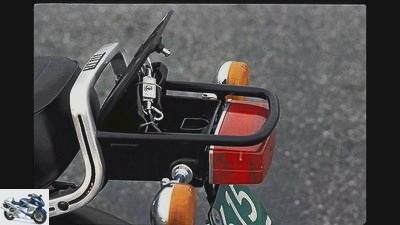
Jorg Kunstle
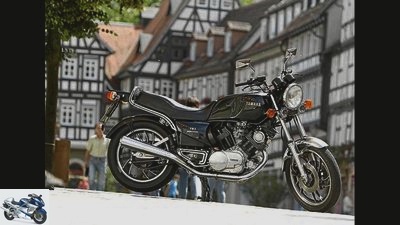
Jorg Kunstle
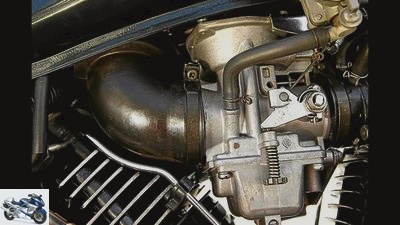
Jorg Kunstle
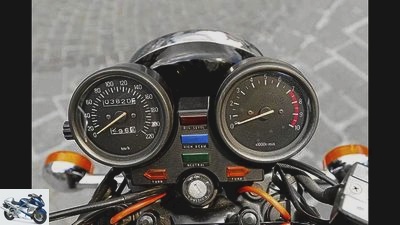
Jorg Kunstle
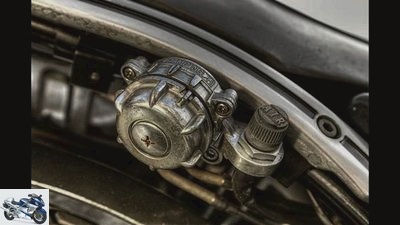
Jorg Kunstle
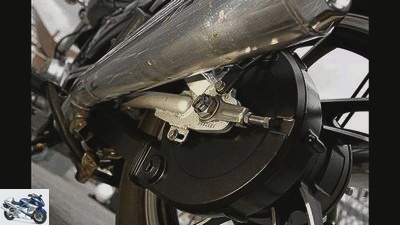
Jorg Kunstle
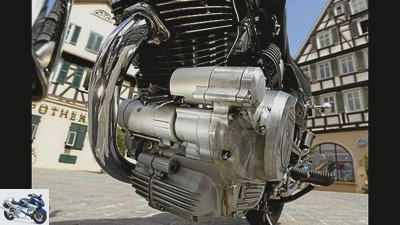
Jorg Kunstle
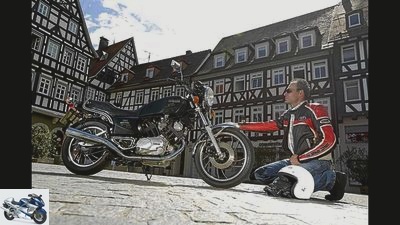
Jorg Kunstle
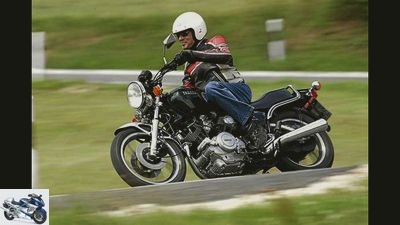
Jorg Kunstle
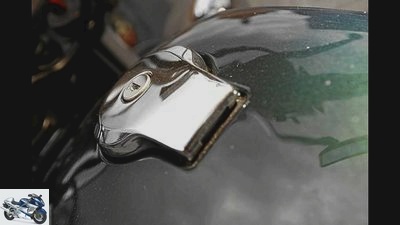
Jorg Kunstle
Related articles
-
Yamaha TZR 250 and Adler MB 250
Volker Rost 14 pictures Volker Rost 1/14 two-stroke rockets Yamaha TZR 250 and Adler MB 250. Volker Rost 2/14 two-stroke rockets Yamaha TZR 250 and Adler MB …
-
On the move with Kawasaki GPZ 900 R and Yamaha FJ 1100
fact 39 pictures fact 1/39 Hurry with a while, always slowly with the young horses – sayings like these were definitely not up for debate when the …
-
Driving report Yamaha XVS 1300 A Midnight Star
Kinrade Driving report Yamaha XVS 1300 A Midnight Star Baby doll With the 1300, Yamaha has added a little sister to the XVS 1900, which was introduced…
-
Comparison test of supersports: Honda CBR 600 F, Kawasaki ZX-6R, Suzuki GSX-R 600, Yamaha YZF 600 R
Comparison test of super sports cars: Honda CBR 600 F, Kawasaki ZX-6R, Suzuki GSX-R 600, Yamaha YZF 600 R Let’s twist again Wake up, people. In the 600s …
-
Innovations Yamaha Vmax model 2009
Yamaha innovations Yamaha Vmax model 2009 New Yamaha Vmax summer slump? Are you kidding me? Are you serious when you say that. The surprising and anti-cyclical presentation of the new Yamaha Vmax …
-
Comparison test: Honda CX 500-650 Turbo, Kawasaki Z 750 Turbo, Suzuki XN 85, Yamaha XJ 650 Turbo
Jahn 21 pictures Jahn 1/21 The preload of the central spring strut of the Suzuki can be easily adjusted. Jahn 2/21 Tight corners and fast …
-
Time travel Yamaha XT 250 and WR 250 F
fact time travel Yamaha XT 250 and WR 250 F half-power A good 20 years of enduro development lie between the two half-power 250s from Yamaha – a …
-
Henniges 7th photos Henniges 1/7 The last one, built in 1990, offered black paint, a silver-coated torso engine, polished hubs and twelve-volt…
-
On the road with the BMW K 75, Triumph Trident T150 and Yamaha XS 750
fact 34 pictures www.factstudio.de 1/34 picture gallery, On the move: BMW K 75, Triumph Trident T150, Yamaha XS 750. www.factstudio.de 2/34 Who on pounding …
-
Big cruisers from Triumph, Yamaha and Suzuki with a lot of displacement
Bilski 20 pictures Bilski 1/20 large cruisers in comparison: Triumph Thunderbird Storm, Yamaha XV 1900 A Midnight Star and Suzuki Intruder C 1800 R Touring …